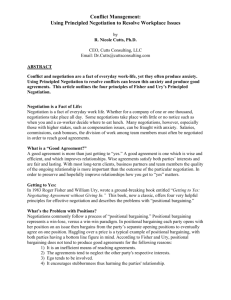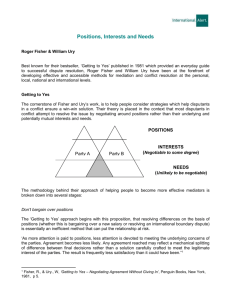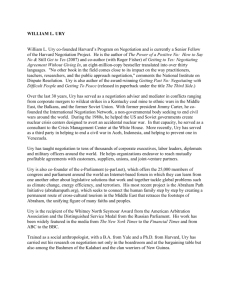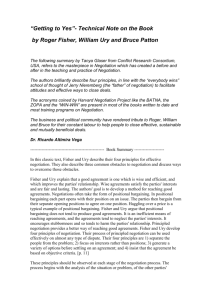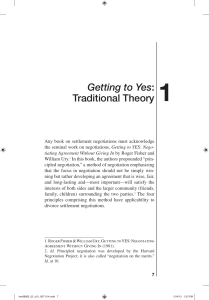1 To give you a relatively brief overview of principled negotiation, I
advertisement
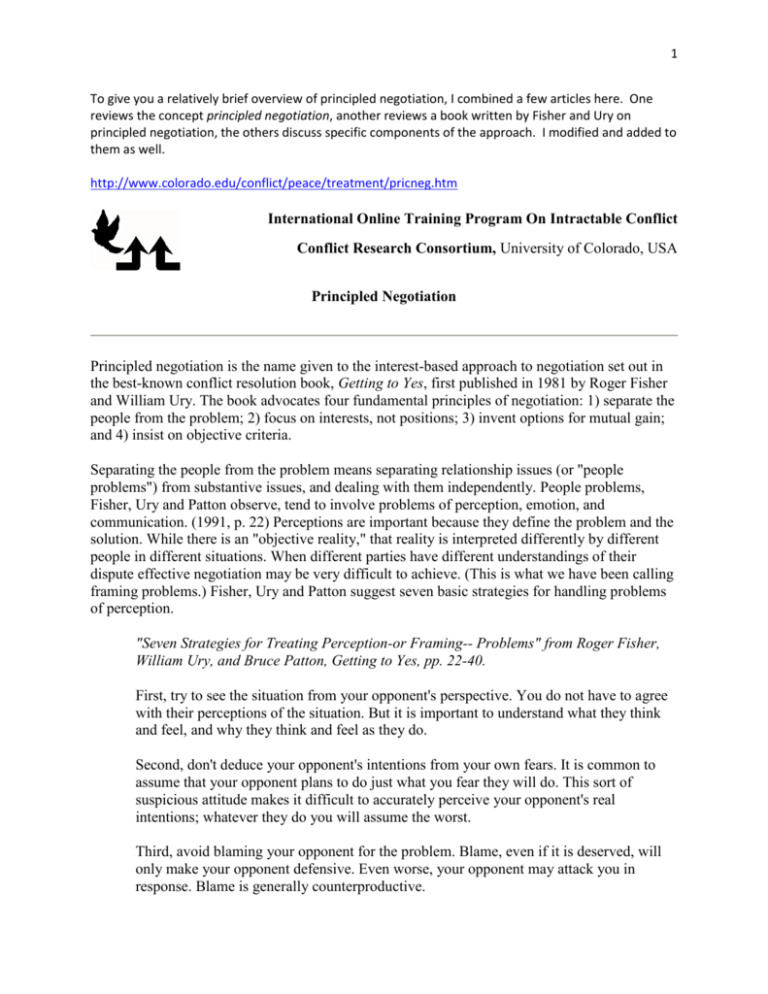
1 To give you a relatively brief overview of principled negotiation, I combined a few articles here. One reviews the concept principled negotiation, another reviews a book written by Fisher and Ury on principled negotiation, the others discuss specific components of the approach. I modified and added to them as well. http://www.colorado.edu/conflict/peace/treatment/pricneg.htm International Online Training Program On Intractable Conflict Conflict Research Consortium, University of Colorado, USA Principled Negotiation Principled negotiation is the name given to the interest-based approach to negotiation set out in the best-known conflict resolution book, Getting to Yes, first published in 1981 by Roger Fisher and William Ury. The book advocates four fundamental principles of negotiation: 1) separate the people from the problem; 2) focus on interests, not positions; 3) invent options for mutual gain; and 4) insist on objective criteria. Separating the people from the problem means separating relationship issues (or "people problems") from substantive issues, and dealing with them independently. People problems, Fisher, Ury and Patton observe, tend to involve problems of perception, emotion, and communication. (1991, p. 22) Perceptions are important because they define the problem and the solution. While there is an "objective reality," that reality is interpreted differently by different people in different situations. When different parties have different understandings of their dispute effective negotiation may be very difficult to achieve. (This is what we have been calling framing problems.) Fisher, Ury and Patton suggest seven basic strategies for handling problems of perception. "Seven Strategies for Treating Perception-or Framing-- Problems" from Roger Fisher, William Ury, and Bruce Patton, Getting to Yes, pp. 22-40. First, try to see the situation from your opponent's perspective. You do not have to agree with their perceptions of the situation. But it is important to understand what they think and feel, and why they think and feel as they do. Second, don't deduce your opponent's intentions from your own fears. It is common to assume that your opponent plans to do just what you fear they will do. This sort of suspicious attitude makes it difficult to accurately perceive your opponent's real intentions; whatever they do you will assume the worst. Third, avoid blaming your opponent for the problem. Blame, even if it is deserved, will only make your opponent defensive. Even worse, your opponent may attack you in response. Blame is generally counterproductive. 2 Fourth, discuss each other's perceptions. Explicit discussion of each side's perceptions will help both sides to better understand each other (see the first point). And discussion will help each side to avoid projecting their fears onto one another (see the third point). Also, such discussion may reveal shared perceptions. Acknowledging shared perceptions can strengthen the parties' relationship, and facilitate productive negotiations. Fifth, seek opportunities to act inconsistently with your opponent's misperceptions. That is, try to disappoint your opponent's worst beliefs and expectations about you. Just as it is important for you to have an accurate perception of your opponent, it is also important for them to have an accurate perception of you. Disappointing your opponent's negative or inaccurate beliefs will help to change those beliefs. Sixth, give your opponent a stake in the outcome by making sure they participate in the negotiation process. If your opponent does not feel involved in the negotiation process, then they are unlikely to feel involved in its outcome. Conversely, if they feel that the process is in part their process, then they are more likely to accept its conclusion as their conclusion. Seventh, make your proposals consistent with the principles and self-image of your opponent. All the parties to a negotiation need to be able to reconcile the agreement with their principles and self-image. That is, they need to feel the final agreement does not compromise their integrity. Proposals which are consistent with your opponent's principles and which do not undermine their self-image are more likely to be accepted. Summary by Tanya Glase http://www.colorado.edu/conflict/peace/example/fish7421.htm People problems also often involve difficult emotions — fear, anger, distrust and anxiety for example. These emotions get intertwined with the substantive issues in the dispute and make both harder to deal with. Fisher, Ury and Patton suggest five tactics for disentangling and defusing emotional problems in the negotiation process. 1. 2. 3. 4. 5. Recognize and understand emotions, theirs and yours. Make emotions explicit and acknowledge them as legitimate. Allow other side to let off steam. Don’t react to emotional outburst. Use symbolic gestures. Fisher, Ury and Patton consider communication problems to be "people problems" as well. They list three types of communication problems. First, disputants may not be talking to each other. While their comments are formally addressed to the opponent, they are actually addressing some outside audience. They are grandstanding, or playing to the crowd. A second communication problem arises when parties are not listening to each other. Rather than listening attentively to the opponent, parties may instead be planning their own response, or listening to their own 3 constituency. Finally, even when parties are both listening and talking to each other, misunderstandings and misinterpretations may occur. Fisher, Ury and Patton suggest techniques for minimizing communication problems. 1. 2. 3. 4. Listen actively and acknowledge what is being said. Speak to be understood. Speak about yourself, not about them. Speak for a purpose. Negotiating about interests means negotiating about things that people really want and need, not what they say that want or need. Often, these are not the same. People tend to take extreme positions that are designed to counter their opponents’ positions. If asked why they are taking that position, it often turns out that the underlying reasons--their true interests and needs--are actually compatible, not mutually exclusive. By focusing on interests, disputing parties can more easily fulfill the third principle--invent options for mutual gain. This means negotiators should look for new solutions to the problem that will allow both sides to win, not just fight over the original positions which assume that for one side to win, the other side must lose. The fourth rule is to insist on objective criteria for decisions. While not always available, if some outside, objective criteria for fairness can be found, this can greatly simplify the negotiation process. If union and management are struggling over a contract, they can look to see what other similar companies have agreed to use as an outside objective criteria. If people are negotiating over the price of a car or a house, they can look at what similar houses or cars have sold for. This gives both sides more guidance as to what is "fair," and makes it hard to oppose offers in this range. Lastly, Fisher, Ury, and Patton counsel negotiators to know what their alternatives are. If you don’t know what your alternatives to a negotiated agreement are, you might accept an agreement that is far worse than the one you might have gotten, or reject one that is far better than you might otherwise achieve. For this reason, Fisher, Ury, and Patton stress the importance of knowing and improving your BATNA (best alternative to a negotiated agreement) before you conclude negotiations. In Getting to Yes, Fisher, Ury, and Patton argue that almost all disputes can be resolved with principled negotiation. They reject the notion that some conflicts are inherently win-lose or that positional bargaining is ever a superior approach. Other theorists, however, disagree--as do we. Principled negotiation is an excellent tool to use in many disputes, but we have found that it needs to be supplemented with other approaches in the case of intractable conflicts. It also is more attuned to U.S. and Western European cultures which emphasize rational cost-benefit analysis, and de-emphasize the importance of relationships and emotions. Cultures which see relationship issues as central aspects of the conflict may find principled negotiation less useful. 4 http://www.colorado.edu/conflict/peace/example/fish7513.htm Conflict Research Consortium BOOK SUMMARY Getting to Yes: Negotiating Agreement Without Giving In by Roger Fisher and William Ury Citation: Roger Fisher and William Ury, Getting to Yes: Negotiating Agreement Without Giving In, (New York: Penguin Books, 1983). This book summary written by: Tanya Glaser, Conflict Research Consortium. In this classic text, Fisher and Ury describe their four principles for effective negotiation. They also describe three common obstacles to negotiation and discuss ways to overcome those obstacles. Fisher and Ury explain that a good agreement is one which is wise and efficient, and which improves the parties' relationship. Wise agreements satisfy the parties' interests and are fair and lasting. The authors' goal is to develop a method for reaching good agreements. Negotiations often take the form of positional bargaining. In positional bargaining each part opens with their position on an issue. The parties then bargain from their separate opening positions to agree on one position. Haggling over a price is a typical example of positional bargaining. Fisher and Ury argue that positional bargaining does not tend to produce good agreements. It is an inefficient means of reaching agreements, and the agreements tend to neglect the parties' interests. It encourages stubbornness and so tends to harm the parties' relationship. Principled negotiation provides a better way of reaching good agreements. Fisher and Ury develop four principles of negotiation. Their process of principled negotiation can be used effectively on almost any type of dispute. Their four principles are 1) separate the people from the problem; 2) focus on interests rather than positions; 3) generate a variety of options before settling on an agreement; and 4) insist that the agreement be based on objective criteria. [p. 11] These principles should be observed at each stage of the negotiation process. The process begins with the analysis of the situation or problem, of the other parties' interests and perceptions, and of the existing options. The next stage is to plan ways of responding to the situation and the other parties. Finally, the parties discuss the problem trying to find a solution on which they can agree. Separating People and Issues 5 Fisher and Ury's first principle is to separate the people from the issues. People tend to become personally involved with the issues and with their side's positions. And so they will tend to take responses to those issues and positions as personal attacks. Separating the people from the issues allows the parties to address the issues without damaging their relationship. It also helps them to get a clearer view of the substantive problem. The authors identify three basic sorts of people problems. First are differences on perception among the parties. Since most conflicts are based in differing interpretations of the facts, it is crucial for both sides to understand the other's viewpoint. The parties should try to put themselves in the other's place. The parties should not simply assume that their worst fears will become the actions of the other party. Nor should one side blame the other for the problem. Each side should try to make proposals which would be appealing to the other side. The more that the parties are involved in the process, the more likely they are to be involved in and to support the outcome. Emotions are a second source of people problems. Negotiation can be a frustrating process. People often react with fear or anger when they feel that their interests are threatened. The first step in dealing with emotions is to acknowledge them, and to try to understand their source. The parties must acknowledge the fact that certain emotions are present, even when they don't see those feelings as reasonable. Dismissing another's feelings as unreasonable is likely to provoke an even more intense emotional response. The parties must allow the other side to express their emotions. They must not react emotionally to emotional outbursts. Symbolic gestures such as apologies or an expression of sympathy can help to defuse strong emotions. Communication is the third main source of people problems. Negotiators may not be speaking to each other, but may simply be grandstanding for their respective constituencies. The parties may not be listening to each other, but may instead be planning their own responses. Even when the parties are speaking to each other and are listening, misunderstandings may occur. To combat these problems, the parties should employ active listening. The listeners should give the speaker their full attention, occasionally summarizing the speaker's points to confirm their understanding. It is important to remember that understanding the other's case does not mean agreeing with it. Speakers should direct their speech toward the other parties and keep focused on what they are trying to communicate. Each side should avoid blaming or attacking the other, and should speak about themselves. Generally the best way to deal with people problems is to prevent them from arising. People problems are less likely to come up if the parties have a good relationship, and think of each other as partners in negotiation rather than as adversaries. Focus on Interests Good agreements focus on the parties' interests, rather than their positions. As Fisher and Ury explain, "Your position is something you have decided upon. Your interests are what caused you to so decide."[p. 42] Defining a problem in terms of positions means that at least one party will "lose" the dispute. When a problem is defined in terms of the parties' underlying interests it is often possible to find a solution which satisfies both parties' interests. 6 The first step is to identify the parties' interests regarding the issue at hand. This can be done by asking why they hold the positions they do, and by considering why they don't hold some other possible position. Each party usually has a number of different interests underlying their positions. And interests may differ somewhat among the individual members of each side. However, all people will share certain basic interests or needs, such as the need for security and economic well-being. Once the parties have identified their interests, they must discuss them together. If a party wants the other side to take their interests into account, that party must explain their interests clearly. The other side will be more motivated to take those interests into account if the first party shows that they are paying attention to the other side's interests. Discussions should look forward to the desired solution, rather than focusing on past events. Parties should keep a clear focus on their interests, but remain open to different proposals and positions. Generate Options Fisher and Ury identify four obstacles to generating creative options for solving a problem. Parties may decide prematurely on an option and so fail to consider alternatives. The parties may be intent on narrowing their options to find the single answer. The parties may define the problem in win-lose terms, assuming that the only options are for one side to win and the other to lose. Or a party may decide that it is up to the other side to come up with a solution to the problem. The authors also suggest four techniques for overcoming these obstacles and generating creative options. First it is important to separate the invention process from the evaluation stage. The parties should come together in an informal atmosphere and brainstorm for all possible solutions to the problem. Wild and creative proposals are encouraged. Brainstorming sessions can be made more creative and productive by encouraging the parties to shift between four types of thinking: stating the problem, analyzing the problem, considering general approaches, and considering specific actions. Parties may suggest partial solutions to the problem. Only after a variety of proposals have been made should the group turn to evaluating the ideas. Evaluation should start with the most promising proposals. The parties may also refine and improve proposals at this point. Participants can avoid falling into a win-lose mentality by focusing on shared interests. When the parties' interests differ, they should seek options in which those differences can be made compatible or even complementary. The key to reconciling different interests is to "look for items that are of low cost to you and high benefit to them, and vice versa."[p. 79] Each side should try to make proposals that are appealing to the other side, and that the other side would find easy to agree to. To do this it is important to identify the decision makers and target proposals directly toward them. Proposals are easier to agree to when they seem legitimate, or when they are supported by precedent. Threats are usually less effective at motivating agreement than are beneficial offers. Use Objective Criteria 7 When interests are directly opposed, the parties should use objective criteria to resolve their differences. Allowing such differences to spark a battle of wills will destroy relationships, is inefficient, and is not likely to produce wise agreements. Decisions based on reasonable standards makes it easier for the parties to agree and preserve their good relationship. The first step is to develop objective criteria. Usually there are a number of different criteria which could be used. The parties must agree which criteria is best for their situation. Criteria should be both legitimate and practical. Scientific findings, professional standards, or legal precedent are possible sources of objective criteria. One way to test for objectivity is to ask if both sides would agree to be bound by those standards. Rather than agreeing in substantive criteria, the parties may create a fair procedure for resolving their dispute. For example, children may fairly divide a piece of cake by having one child cut it, and the other choose their piece. There are three points to keep in mind when using objective criteria. First each issue should be approached as a shared search for objective criteria. Ask for the reasoning behind the other party's suggestions. Using the other parties' reasoning to support your own position can be a powerful way to negotiate. Second, each party must keep an open mind. They must be reasonable, and be willing to reconsider their positions when there is reason to. Third, while they should be reasonable, negotiators must never give in to pressure, threats, or bribes. When the other party stubbornly refuses to be reasonable, the first party may shift the discussion from a search for substantive criteria to a search for procedural criteria. When the Other Party Is More Powerful No negotiation method can completely overcome differences in power. However, Fisher and Ury suggest ways to protect the weaker party against a poor agreement, and to help the weaker party make the most of their assets. Often negotiators will establish a "bottom line" in an attempt to protect themselves against a poor agreement. The bottom line is what the party anticipates as the worst acceptable outcome. Negotiators decide in advance of actual negotiations to reject any proposal below that line. Fisher and Ury argue against using bottom lines. Because the bottom line figure is decided upon in advance of discussions, the figure may be arbitrary or unrealistic. Having already committed oneself to a rigid bottom line also inhibits inventiveness in generating options. Instead the weaker party should concentrate on assessing their best alternative to a negotiated agreement (BATNA). The authors note that "the reason you negotiate is to produce something better than the results you can obtain without negotiating."[p. 104] The weaker party should reject agreements that would leave them worse off than their BATNA. Without a clear idea of their BATNA a party is simply negotiating blindly. The BATNA is also key to making the most of existing assets. Power in a negotiation comes from the ability to walk away from negotiations. Thus the party with the best BATNA is the more powerful party in the negotiation. Generally, the weaker party can take unilateral steps to improve their alternatives to negotiation. They must identify potential opportunities and take steps to further develop those opportunities. The weaker party will have a better understanding of the negotiation context if they also try to estimate the other side's BATNA. Fisher and Ury conclude that "developing your BATNA thus not only 8 enables you to determine what is a minimally acceptable agreement, it will probably raise that minimum."[p. 111] When the Other Party Won't Use Principled Negotiation Sometimes the other side refuses to budge from their positions, makes personal attacks, seeks only to maximize their own gains, and generally refuses to partake in principled negotiations. Fisher and Ury describe three approaches for dealing with opponents who are stuck in positional bargaining. First, one side may simply continue to use the principled approach. The authors point out that this approach is often contagious. Second, the principled party may use "negotiation jujitsu" to bring the other party in line. The key is to refuse to respond in kind to their positional bargaining. When the other side attacks, the principles party should not counter attack, but should deflect the attack back onto the problem. Positional bargainers usually attack either by asserting their position, or by attacking the other side's ideas or people. When they assert their position, respond by asking for the reasons behind that position. When they attack the other side's ideas, the principle party should take it as constructive criticism and invite further feedback and advice. Personal attacks should be recast as attacks on the problem. Generally the principled party should use questions and strategic silences to draw the other party out. When the other party remains stuck in positional bargaining, the one-text approach may be used. In this approach a third party is brought in. The third party should interview each side separately to determine what their underlying interests are. The third party then assembles a list of their interests and asks each side for their comments and criticisms of the list. She then takes those comments and draws up a proposal. The proposal is given to the parties for comments, redrafted, and returned again for more comments. This process continues until the third party feels that no further improvements can be made. At that point, the parties must decide whether to accept the refined proposal or to abandon negotiations. When the Other Party Uses Dirty Tricks Sometimes parties will use unethical or unpleasant tricks in an attempt to gain an advantage in negotiations such as good guy/bad guy routines, uncomfortable seating, and leaks to the media. The best way to respond to such tricky tactics is to explicitly raise the issue in negotiations, and to engage in principled negotiation to establish procedural ground rules for the negotiation. Fisher and Ury identify the general types of tricky tactics. Parties may engage in deliberate deception about the facts, their authority, or their intentions. The best way to protect against being deceived is to seek verification the other side's claims. It may help to ask them for further clarification of a claim, or to put the claim in writing. However, in doing this it is very important not to bee seen as calling the other party a liar; that is, as making a personal attack. Another common type of tactic is psychological warfare. When the tricky party uses a stressful environment, the principled party should identify the problematic element and suggest a more comfortable or fair change. Subtle personal attacks can be made less effective simply be recognizing them for what they are. Explicitly identifying them to the offending party will often 9 put an end to suck attacks. Threats are a way to apply psychological pressure. The principled negotiator should ignore them where possible, or undertake principled negotiations on the use of threats in the proceedings. The last class of trick tactics are positional pressure tactics which attempt to structure negotiations so that only one side can make concessions. The tricky side may refuse to negotiate, hoping to use their entry into negotiations as a bargaining chip, or they may open with extreme demands. The principled negotiator should recognize this as a bargaining tactic, and look into their interests in refusing to negotiate. They may escalate their demands for every concession they make. The principled negotiator should explicitly identify this tactic to the participants, and give the parties a chance to consider whether they want to continue negotiations under such conditions. Parties may try to make irrevocable commitments to certain positions, or to maketake-it-or-leave-it offers. The principled party may decline to recognize the commitment or the finality of the offer, instead treating them as proposals or expressed interests. Insist that any proposals be evaluated on their merits, and don't hesitate to point out dirty tricks. http://www.colorado.edu/conflict/peace/example/fish7513.htm Conflict Research Consortium ARTICLE SUMMARY "Overcoming Barriers to Principled Negotiation" by William Ury Citation: William Ury, "Overcoming Barriers to Principled Negotiation" in Getting Past No.Bantam: 1990. After publishing the first edition of Getting to Yes in 1981, Fisher and Ury were deluged with questions and challenges. "What do you do when people won’t play along?" "What about situations where there is no possible win-win outcome?" "What happens when people respond with unfair tricks?" In addition to answering some of these questions in the revised edition, which came out in 1991, Ury also attempted to answer some of these questions in a sequel called Getting Past No, published in 1990. This book presents five steps of what Ury calls "breakthrough negotiation"--negotiation designed to break through obstacles and obtain win-win agreements with people who are initially resistant to such approaches. The five steps of breakthrough negotiation are: 1) Don’t react to provocations. Step away from the scene, calm down, and carefully plan your response. Do not respond automatically, because most automatic responses are negative and further escalate the situation. 2) Step around obstacles, don’t walk right into them. Use active listening to defuse negative feelings, and use I-messages to express your feelings. Agree whenever you can, but stand up for your principles as well. 10 3) Ask people "why?" "why not?" or "how is that fair?" to try to move them away from positional bargaining toward principled negotiation. 4) Make it easy for the opponent to agree by making the offer as attractive as possible 5) Make it hard for them to walk away by proving that the negotiated agreement is better than their alternatives. "Bring them to their senses, not their knees," Ury advises. Copyright © 1998-2005 Conflict Research Consortium -- Contact: crc@colorado.edu
